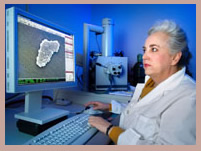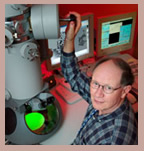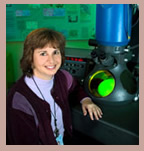Careers at CDC
CDC Microscopics
Come with us on an adventure into a microscopic world tinier and more fascinating than the one Alice faced in her adventures in Wonderland. Instead of journeying down a rabbit hole, we travel through the lens of an electron microscope to find things "curiouser and curiouser."
First up is the Environmental Scanning Electron Microscope (ESEM). There are only three in the southeast, only one in Georgia and it′s here at CDC in Atlanta.

"The ESEM′s primary advantage lies in permitting the microscopists to vary sample environment through a range of pressures, temperatures and gas compositions," said microbiologist, Janice Carr, DHQP.

The Electron Microscope (EM) lab provides collaborative support and diagnostic research expertise for outbreaks and research projects by permitting detailed examinations of surfaces, shapes and textures. The resolution can show three-dimensional relationships among infectious agents and living and inanimate surfaces.
Carr explained that such images are not only valuable scientifically, but visually dramatic and easily understood by the lay public.
"Even if you don′t have a lot of scientific knowledge, these photos are something people can really relate to. They just make science come alive," she said.
This amazing instrument has a beam smaller than a pencil point and it magnifies up to 100,000 times! It′s first mission is to support epidemic investigations, but it′s also used in virology, mycology and parasitology.
From butterfly wings to bacteria on wood, Carr, who′s worked in CDC’s EM lab for 20 years, comes up with amazing and beautiful images.
"I can spend hours and hours looking at one sample," she said.
Processing is difficult, however. "Nothing that goes in can have water in it or it will explode in the high-intensity beam," Carr explained. "But, if you dehydrate the sample too quickly, it collapses."

Charles Humphrey, another electron microscopist, has been at CDC since 1983. His work involves any and everything related to viruses and other agents. He′s a specialist in negative stain and said he likes "the difficulty involved in the job."
"I enjoy finding the very small particle in low titer mixed in with many things," Humphrey explained. Though some may find this tedious, Humphrey said "it′s an engaging challenge . . . and rare experience to get to see the beautiful things in something that is not really beautiful at all."
His job takes skill. There are several hundred grid squares on a grid and he has to work without destroying the agent of interest. Searching through the microscope is like looking for a particle in something the size of a football field. But Humphrey said this is rewarding.
"The reward is when you have been struggling and you find something. That′s the joy."
Humphrey fell in love with the instrument while in graduate school at Clemson. "Not many universities had an EM back then. I got to use it if I helped the engineers keep it up," he said.
Humphrey′s work is largely in gastrointestinal diseases. He gets images for review and is often asked to make identifications. He recalled years ago when he received an image of a rotavirus from Vietnam.
"I was able to identify it quickly and they had their answer back in just a couple of hours," he said.

Cynthia Goldsmith, IDPA/DVRD/NCID, is a research biologist. She′s been at CDC over 20 years and has spent the entire time working with the electron microscope, a skill learned at Yerkes Primate Center, where she worked for five years.
"I enjoy my job because I get to work with the best people at CDC," she said. "My work depends on the specimens they send me, so it′s always something different. It′s fascinating to figure out what the pathogen is."
Get email updates
To receive email updates about this page, enter your email address:
Contact Us:
- Centers for Disease Control and Prevention
1600 Clifton Rd
Atlanta, GA 30333 - 800-CDC-INFO
(800-232-4636)
TTY: (888) 232-6348
24 Hours/Every Day - cdcinfo@cdc.gov

